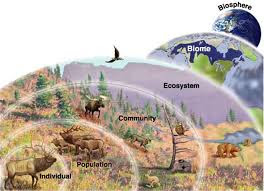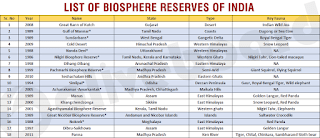Key Learning Points-Deforestation, Drought, Desertification, Protected areas- Biosphere Reserves, National parks, wildlife centuries, Flora, Fauna, Endemic Species, Red Data Book, Migration, recycling of Paper and afforestation.
Introduction-Different varieties of plant, animals and microorganisms are found on the earth. They are different from each other in many ways. Their geographical distributions as like in tropical, subtropical, temperate and polar region is also different. There are about 1.7 million known species. There are 1.2 million species of animals and 0.5 million species of plants. The different varieties of plants, animals and micro-organisms are together called as ‘biodiversity’. Out of 12 mega-biodiversity regions of the world, India is one among them. Due to climate change, natural and man-made causes the biodiversity is under threat. The sphere of the earth where living organisms are found is called biosphere.
Deforestation- Forest is a natural resource. The clearing of forests on large scale and using that cleared land for other purposes is called deforestation.
Causes for deforestation-
1. Encroaching forest land for cultivation and other purposes.
2. Making houses, developing colonies, road, airport and factories.
3. Using wood as fuel or making furniture.
4. For mining, ores extraction, petroleum extraction etc.
5. Some natural causes of deforestation are forest fires and drought.
Consequences of deforestation-The
consequences of deforestation are
1. Soil erosion and decrease in soil fertility leading to desertification.
2. Rise in the temperature and pollution level
3. Increase in the level of carbon dioxide in the atmosphere leading to global warming.
4. Climate change
5. Lowering of ground water level.
6. Disturbs the biodiversity.
7. Decrease in rainfall and water cycle leading to drought.
8. Shortage of forest products
9. Decrease in the water holding capacity of soil causing floods.
Drought- When number of trees will be less then less carbon dioxide will be used up resulting in its increased amount in the atmosphere. This will lead to global warming because CO2 traps the heat rays reflected by the earth. The increase in temperature on the earth disturbs the water cycle and may reduce rainfall. This may cause droughts.
Desertification-Removal of top layer of soil exposes the hard and rocky lower layers, which have very less humus and air. As they are less fertile, soil becomes like desert. It is termed as desertification.
Forest- A vast area covered with numerous trees and wild animals is called forest. Forests have ecological, economic and aesthetic value. Forest is beneficial for us in many ways as they provide-food, fodder, gum, resin, tannin, rubber, latex, animal products like horn, fur, skin, drugs, medicines, habitat for wild animals including birds, habitat of different varieties of plants, paramount role in climate control, water cycle, controlling flood, oxygen-carbon id-oxide cycle, nutrients recycling etc. But, due to climate change, natural and man-made causes the forests are under threat. So, their conservation is essential to conserve wildlife. As per norms forest should be more than 33% of total area but it’s about 22 % only.
Conservation of forest and wildlife- Forest and wildlife can be conserved by setting up areas like
Biosphere reserves, Wildlife sanctuaries, National parks, etc.
i) Biosphere reserves- They are large areas of protected land for conservation of biodiversity and the traditional life of the tribals living there. There are 18 biosphere reserves in India. e. g- Panchmarhi The Panchmarhi Biosphere Reserve consists of a National Park called Satpura National Park and two wildlife sanctuaries called Bori and Pachmarhi.
ii) National parks are areas reserved for wildlife where they can freely use the habitats and natural resources. There are 101 National parks in India. They cover more than 40 thousand square kilometre of area. It is 1.23 % of total area of India. Satpura National Park is the First Reserve Forest in India. e.g.- Jim Corbett National park, Uttarakhand, Kanha National Park, Keoladev national park, Bhartpur etc
For further reference visit on www.examstocks.com
iii) Wildlife sanctuaries-They are areas where animals are protected from any disturbance to them or their habitat. There are 553 wildlife sanctuaries in till date. They are about 3.64 % of total area and cover about one lakh twenty thousand square kilometres. e.g.- Black buck sanctuary , Buxar, Bihar
Flora and fauna
Flora and fauna are natural
resources. They are members of different species. They are found in different
regions of the biosphere. Some are exclusively located to a particular area.
Others are wide spreaded globally. Biodiversity is the variety of plants,
animals and microorganisms found in the area. The biodiversity consist of
different verities of plants and animals. All the different varieties of plants
are called as flora and all the different verities of animals are called as
fauna.
The flora of Panchmarhi consists of
sal, teak, wild mango, jamun, silver ferns etc.
The fauna of Panchmarhi consists of wild dog,
cheetal, wolf, leopard, blue bull, barking deer etc.
SPECIES-
A group of population capable of interbreeding is called a species.
e. g. - Cats, Tigers, Deer,
Tomato, Mango etc.
The animal species reproduce to form young ones of their own kind only.
But, when breeding occurs in between members of different species, any
different kind of individual is formed.
e. g.- Hinny, is the infertile hybrid organism of reproduction between male
horse (Stud/Stallion) and female donkey.
e. g.- Mule, is the infertile hybrid offspring of am male donkey and
female horse (mare).
Endemic Species -Endemic species are those species of plants and
animals found only in a particular area and not found anywhere else. Those
species of organisms which are exclusively found in any particular area are
called endemic species.
e. g.- Sal Trees and Wild Mango are
two endemic flora species of the Panchmarhi Biosphere reserve.
e. g.- Bison, Indian Giant Squirrel and Flying Squirrel are the endemic
fauna species of Panchmarhi Biosphere reserve.
A particular type of species is endemic to a zone, state or a country.
Destruction of their habits, introduction of new species, introduction of new
species and diseases are some reasons why endemic species are in greater danger
of becoming extinct.
Project Tiger
Project Tiger was launched on 1st April 1973 by the government of India. The project aimed at ensuring a viable population of tiger in their natural habitats and also to protect them from extinction and preserving areas of biological importance as a natural heritage. The project's task force visualized these tiger reserves as breeding nuclei, from which surplus animals would migrate to adjacent forests.
Red Data Book- The book provides a central information source in organizing studies and monitoring programs on rare and endangered species and their habitats. It is regularly consulted when developing and implementing special measures for the protection and rehabilitation of such species. Red Data Books are books which keeps a record of all endangered plants and animals. These volumes of red data book are maintained by World Conservation Union (W.C.U.). It was earlier called as International Union of Conservation of Nature and Natural resources (I.U.C.N.).The indiscriminate hunting, killing and destroying of forest are main causes for loss of animals. There are three main categories of animals- vulnerable, endangered and extinct.
Vulnerable Animals- Those animals which are low in number and may become endangered if exploitation and deforestation continues are called vulnerable animals. e.g.- Red panda, One- horned Rhino, Olive Ridley Turtle etc.
Endangered Animals –Those animals which are extremely low in number and not protected will become extinct. e.g.– Tiger, Musk deer, Indian bustard etc. It is a record of endangered species of plants and animals.
Extinct Animals- Those animals which were once alive but now not found on the earth are called extinct. e.g.- Dodo, Dinosaur, Cheetah, Pink headed duck, mountain quail etc.
Ecosystem -An ecosystem consists of all the plants, animals and microorganisms living in an area along with the non living components like climate, water, soil, river deltas etc. An ecosystem consists of biotic and abiotic factors.
Biotic/ Living factors like plants, animals and micro-organisms
Abiotic/ Non-living/ Physical factors like water, sunlight, temperature, soil, air, humidity, rainfall and heat.
Migration -Migration is the movement of animals from its own habitat to some other habitat for a particular time period due to climatic changes, in search of food or for breeding. Those birds which fly very long distances to reach another land are called migratory birds.
e.g- Arctic tern, Siberian Crane
etc
Recycling of Paper -About seventeen full grown trees are required to produce one tonne of paper. Paper can be recycled about five to seven times for next use. We should save, reuse and recycle paper to save not only trees but also to save the energy, water and chemicals used to make paper.
3R- Reduce, Reuse and Recycle
Reforestation - Reforestation is the restoring of destroyed forests by planting new trees. We should plant at least as many trees as we cut. We have already caused a lot of damage to our forests. If we have to regain our green wealth, reforestation is the only option.













Sir. Some. Picture are. Deficult.to draw
ReplyDeleteSorry diffcult
ReplyDelete